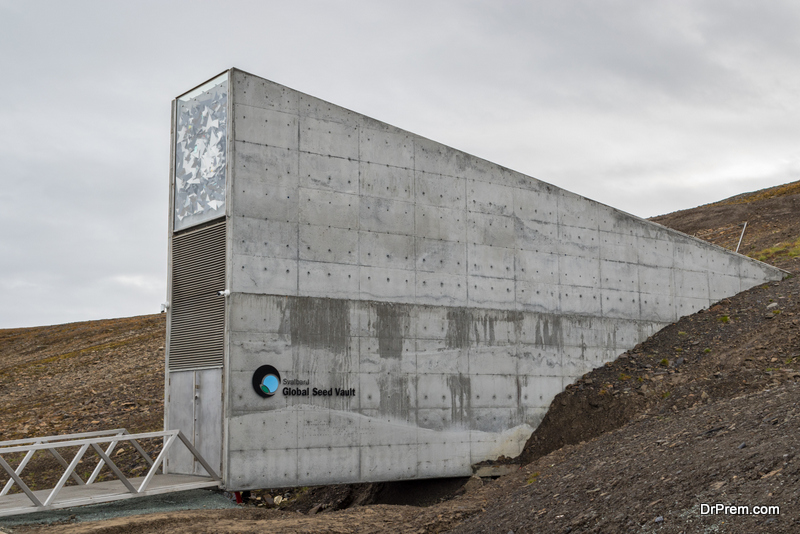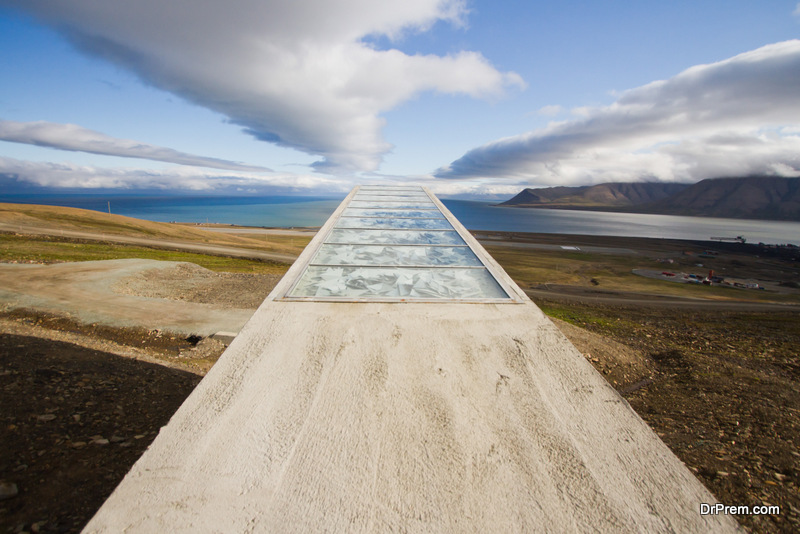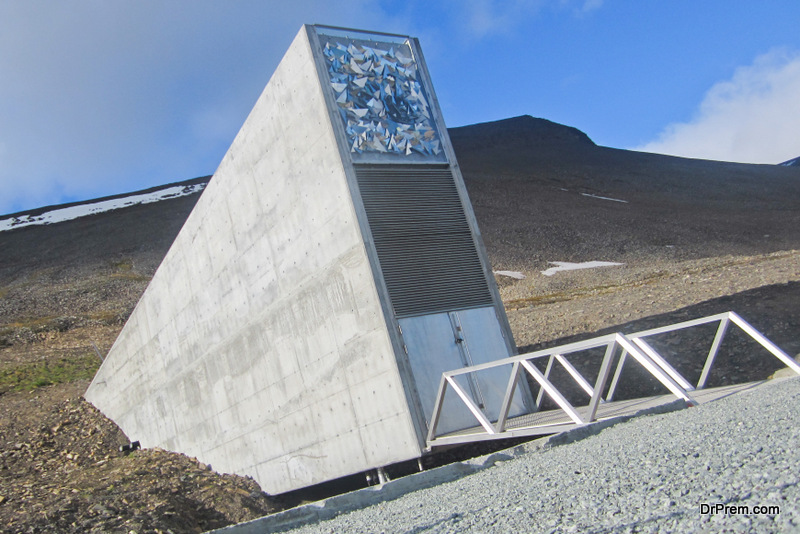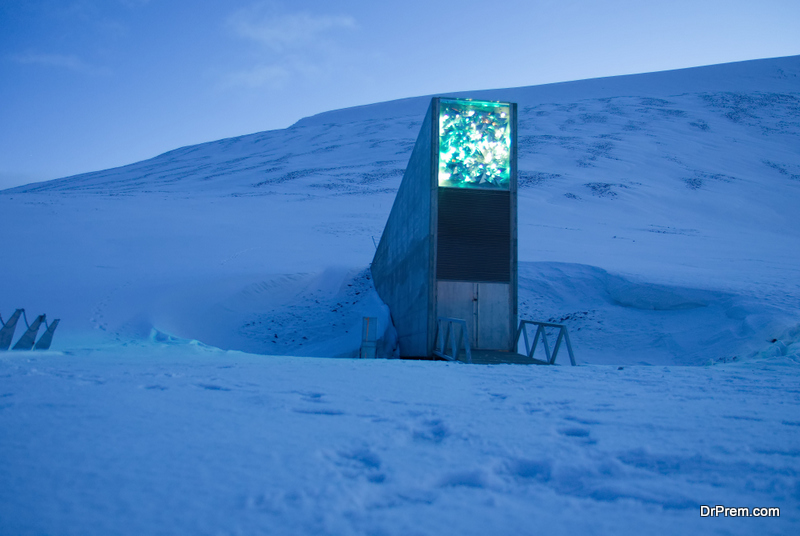Established on a remote island in the Arctic ocean, Svalbard Global Seed Vault is a facility that has the world’s largest collection of seeds. The purpose to store the seeds is to use them in case of any natural disaster or if any of the species are lost due to any global catastrophe. That’s why global seed bank is also dubbed as the doomsday vault and Noah’s Ark.
Location and construction
The vault is built at Spitsbergen, which is the biggest islands in Svalbard archipelago. This location was chosen by the government because of its cold conditions and frozen ground with a temperature lower than 3 to 4 degree Celsius (32 degrees Fahrenheit). Site construction began in 2006 and celebrated its opening with the first consignment of seeds on 26th February 2008. The first lot of 278 000 seed samples comprised mostly wheat and rice.
The facility that completed ten years now is managed by the Norwegian ministry of agriculture and food, the Crop Trust and the NordGen (Nordic Genetic Resource Centre). Norwegian government owns the most diverse collection of seeds across the globe, which is coordinated by Åsmund Asdal. It is not open for tourists or any visitors but you can take organized trips with a guide to see the entrance.
The storage area covering 1, 000 square meters has three halls with artificial cooling systems to maintain a temperature of minus 18 degree Celsius. All the three halls are 120 meters inside the mountain Platåberget. Such surroundings inside the global seed bank ensure reduced metabolic activity and the natural cold climate keep the seeds safe even if the cooling system fails. At this freezing temperature, seeds will never develop and their aging will be delayed.
The first portion of the vault is a man-made tunnel that is not watertight. It has seen water logging and warm climate in the last few years. But, the Norwegian government is going to spend 100 million Norwegian krone to make it watertight.
In addition to the favorable climate, the vault is an ideal location for long time seed storage because of a few other reasons:
a. Svalbard has a local airport, so one can fly there whenever required. So, it is a remote location but still accessible.
b. The global seed bank is near a well-established area, Longyearbyen that gives it a geological and political benefit. Longyearbyen is just a kilometer away from the Svalbard airport.
c. It is well above sea level. Even in the worst case scenario of sea level rise, it is protected from flooding.
d. Vault is constructed to withstand up to 10 seismic waves on Richter’s scale.
On the vault’s roof and top of the entrance, you will see the artwork by Dyveke Sanne, dubbed as ”Perpetual Repercussion”. Made with triangular acid safe steel pieces, it makes the global seed bank visible during the day as well as night.
Motive
The vulnerability of seed banks located across the globe was the main cause to establish a backup storage. That’s why Svalbard global seed bank was established, which stores seed samples from crop collecting gene banks across the world. It is now an insurance policy for our future generation who will not face any lack of food supply even if there will be any climatic changes or huge population growth. It can secure today’s crop seeds for centuries.
Necessity

More than 1700 seed banks are already storing different crop varieties, but many of them are vulnerable to natural disaster, wars and in fact avoidable scenarios like poor management and lack of funds. Small errors like a non-working freezer can ruin the entire seed collection, which will be irreversible just like the extinction of mammoths and saber-tooth tigers.
The Repository
The global seed bank is capable of storing 2.5 billion seeds including 500 seeds of each 4.5 million crop varieties. Every 500 seeds are packed in three-ply aluminum bags by the genes banks. Then a maximum of 400 bags is stored in different containers.
With contributions from more than 76 depository institutions, currently, the vault has 968, 557 samples. The samples originate from almost every part of the world. Whether it is maize, wheat, rice, cowpea or sorghum from Asia and Africa or eggplant, barley, lettuce or potato from South America and Europe, it has all the varieties.
The depository institutions or gene banks own the seeds. They can withdraw the seeds in case of an emergency. A recent example comes from war-affected Syria, first country to make the withdrawal, where access to the gene bank in Aleppo was impossible in 2015. The International Center for Agricultural Research (ICARDA) that is responsible to handle Aleppo gene bank took seeds from Svalbard that was here as a backup storage for Aleppo gene bank. Research center personals took the seeds to the gene banks at Morocco and Lebanon. Within two years, seeds were grown successfully and then transferred back to the Svalbard global seed bank.
On the tenth anniversary of the vault, 77,671 seeds were added. Due to the withdrawal of 92,430 seeds by ICARDA, the current sample count is 968,557, otherwise, it could have been more than one million, that is 1,060,987.
Monitoring
None of the seeds lives forever. Gene banks located across the world monitor the viability of stored seeds. Once the gene bank sees that any of the samples is losing viability, they multiply, regenerate new ones and replace the same at Svalbard vault. In other words, testing the seed’s viability is the responsibility of gene banks. A Black Box system ensures that only the depositor has the access to seeds stored by them. Apart from the depositor, no one else is allowed to access the seed samples.
The vault follows international laws before accepting seeds from any depositors. It only allows the storage if the seeds are grown in the depositor’s country or are shared under either the Multilateral System or Article 15 of the International Treaty.



